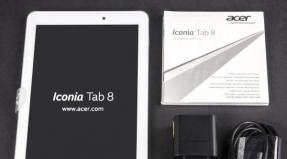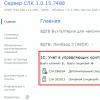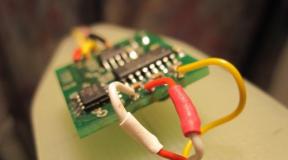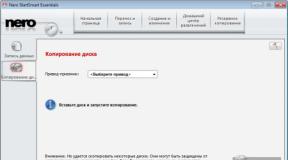How to check your phone's certification. "Grey" and "white" Selling by hand
For reference:
Do not confuse “gray” mobile phones with Chinese fakes (counterfeit). Counterfeit phones are not at all the devices they claim to be. This is, in fact, a counterfeit, and the buyer is not paying for the product he wanted to buy.
“Gray” phones are made at official factories. They are simply intended for sale in other countries. They have not passed the appropriate certification in our country and do not have a declaration of conformity. This means that they cannot be considered safe for human health and the environment. By the way, a phone purchased in a single copy, in a foreign offline or online store, and imported into Russia really for personal use, is also considered “gray”.
Viktor Lukanin, executive vice president of Euroset:
Gray mobile phones account for about 4-5% of the market. Such devices are brought literally “in suitcases” in small batches, which are later sold on their websites or resold to “gray” online stores.
They are often imported, bypassing legal suppliers, before sales start in the showrooms of official retailers. There are no advantages to purchasing such devices, because... the client is deprived of warranty service in case of problems with the device.
The models of imported “gray” phones are determined by the popularity of certain devices on the official market. Of course, most often they carry Apple devices because of their demand, but they can also bring various Chinese models that are not certified in the Russian Federation and, accordingly, are not on the official market.
We, as an official retailer, have a negative attitude towards gray imports.
5 real disadvantages of a “gray” mobile phone
The lifespan of “illegals” is until the first breakdown.
The probability of correct operation of “gray” devices is not high. In the event of a breakdown, the consumer will not be able to do anything with the phone.
"Gray" phones are often not only sold without documents confirming their compliance with the requirements, but do not meet mandatory requirements
Fine and confiscation?
For reference:
In most countries there is no concept of “grey” phones. The reason is low taxes. Because of this, the difference in price between white and gray is leveled. In Russia, taxes are high. Unofficial import allows you to reduce the price by reducing tax costs.
According to the list of communications equipment subject to mandatory certification, smartphones are not included. Mobile phones are among the means of communication that are subject to declaration. Communication facilities subject to mandatory certification include various telephone exchanges, data processing equipment, repeaters, satellite communication stations, etc.
Mobile phones are not certified as communication devices, but as low-voltage equipment. Therefore, ordinary citizens will not be affected by fines.
The law concerns primarily unscrupulous mobile operators who purchase equipment that has not been certified, and sellers of communication equipment that do not have a declaration of conformity. The fine for a mobile phone for a legal entity now ranges from 60 to 150 thousand rubles (with or without confiscation).
Will this measure be effective? Yes, the state does not receive enough taxes. It is quite logical that it cannot remain on the sidelines. But it is impossible to solve the problem with gray phones by simply increasing fines. A fine of 150 thousand for a seller who makes millions in profits is insignificant. Further, it is difficult to collect these fines. Usually, reputable companies do not sell gray phones. These are fly-by-night companies. They came to fine them - but they are no longer there. What can improve the situation?
It is also important to convey to the ordinary buyer all the disadvantages of buying illegal goods. Especially the fact that when buying a cheap “gray” phone, you do not win, but lose money. The educational function can again be taken on by a public organization that is ready to defend consumer rights; a strong and powerful protector who is trusted.
And of course, the consumer must be sure that his reports of observed violations will be addressed. Every call, every complaint will be verified by a motivated business association. Each actual violation will result in legal action, possibly initiated by the manufacturers. After all, now unscrupulous sellers feel unpunished precisely because consumers rarely file lawsuits. The process can take a year, and the maximum that the consumer can manage is to compensate for the cost of the phone.
Only by closing the system of responsibility will we get the result we are striving for now.
The topic of uncertified equipment imported into Russia has been discussed more than once on the Internet and other media. GSM cell phones have become not just commonplace, but already banal. “Well, who doesn’t have a mobile phone now?!” any of the 140 million inhabitants of our huge country will exclaim. There are as many devices intended for sale in other countries Ukraine, Italy, Turkey, England, illegally imported into the territory of Russia as the number of residents of the Russian Federation.For example, when importing a mobile phone to Ukraine, you are not required to pay customs duties, which means that phone N, imported to Ukraine, will cost x dollars less than the same device N, but imported to Russia, where you will have to pay customs duty for import.
What should you pay attention to when purchasing a cell phone? These are the five simple rules below. Please note that compliance with one or more of these rules does not mean that a cell phone is legal to import into our country. If at least one of the points is not in your favor, you should know that you risk purchasing a “gray” phone. Remember, you can check the legality of the device at the manufacturer’s support service: just call the call center and give the name (IMEI) of the device, which will be checked by a contact center employee.
Of course, we should not forget that the IMEI code under the back cover of the device must match the one that we can see by typing *#06# on the keyboard, as well as the one indicated on the package. The box of a legally imported phone must contain a warranty card in Russian: for Samsung it is a branded warranty card on glossy paper, for Nokia it is a page almost at the end of the operating instructions, for LG, Motorola and Sony Ericsson it is a branded card, etc.
Let's say you've read this far on the page and decided to look under the cover of your phone to check if it's gray. I don’t know whether to be happy or sad, but# if it becomes clear that your phone has not been certified for sale in Russia, do not despair. Unlike a “white” phone, an “illegal” one will work no worse (unless, of course, it is some device that can only operate at a frequency of 1900 MHz; in Russia they use the 900 and 1800 MHz bands). By purchasing an uncertified device, you lose:
- a) free repairs and maintenance at authorized service centers of phone manufacturers (always);
- b) Russian letters on the keyboard (not always);
- c) the convenience of full-fledged professional Russification: 1) compatibility with SMS messages written in Russian (unreadable text may be received, but not necessarily); 2) readable responses after USSD requests like *102# (not always); 3) you lose the ability to read broadcast messages from the operator’s network in Russian (not always), although some legally imported models, for example Samsung, still do not always work correctly with Cyrillic;
- d) complete set (however, there are cases when the “gray” set prevails over the “white” one, for example, the “gray” set comes with a 256 MB memory card instead of a 64 MB one);
- e) often, having bought a “gray” phone, you also lose the opportunity to receive assistance from cell phone manufacturers’ support centers (by phone or via the Internet) or register in vendor fan clubs on their websites;
- f) due to the prestige of owning legal things lately (for example, a licensed copy of Windows XP Professional or other software), you are depriving yourself of the opportunity to announce to your family, friends or colleagues that you have a “white” (!) phone .
With the advent of the crisis on the Russian market, prices for smartphones, and indeed for all equipment, began to bite. For many, the way out of this situation was the so-called « gray » smartphones. How safe, legal and convenient it is, read more in our article!
What's happened « gray » smartphones
Large smartphone manufacturers rarely limit themselves to one market for selling their products. Devices from brands such as Samsung, Xiaomi, ZTE, Meizu, Lenovo can be found in many countries in Europe, Asia and the countries of the Customs Union. « Gray » a smartphone means that the product was imported into your country illegally, that customs duties were not paid for it, and the manufacturer does not provide its official guarantee.
Initially, this smartphone could have been intended for sale in Europe or Asia, but thanks to the cunning of entrepreneurs and holes in the legislation, it can be purchased in our country, and much cheaper than from an official dealer.
We also note that certification « growth » absolutely does not mean that the device has been tested and studied by a group of scientists using various equipment and found to be absolutely safe. As a rule, this is a simple formality, and the certification center checks the product for the presence of Russian-language software, instructions, and for compliance with the declared and actual characteristics.
Example prices at the time of writing:
Xiaomi Redmi Note 4 32GB (black) — RUB 14,999 on the liaison website.
Xiaomi Redmi Note 4 32GB (Black) — 9790 RUR in one of the Yandex.Market stores.
The overpayment is simply huge - 50%, but in fact, the devices are absolutely identical.
A few words about the PCT
Many people still ask the seller about the treasured three letters when choosing a smartphone « PCT » . The fact is that PCT, recently, is not a mandatory certification, but a voluntary one. It no longer affects anything and does not oblige you to anything. With the advent of the Eurasian Economic Union, mandatory certification since August 2013 is called EAC ( Eurasian correspondence). Therefore, if the seller answers in the affirmative to the question whether the device is PCT, this means that the device is still EAC, and the seller is too lazy to explain all these subtleties to you, but yes, it has passed certification. Therefore, it is best to ask if the device has an official warranty from the manufacturer, this way you will save time.

Is this legal
Absolutely legal. The seller can sell and you can buy « grey » phone as much as you like. We have no laws prohibiting you from doing this. No one will confiscate your devices. Smartphones are not included in the list of devices that are subject to mandatory certification.
How safe is it?
If purchased « gray » The device is not a fake, but an original, then there is no difference between it and the same model for the Russian market. Here you can rather speculate on how safe cell phones are in principle. There are many videos on YouTube about iPhones spontaneously combusting, and the explosive Samsung Note 7 has become a meme.

What are the differences?
First of all, you need to find out for which market the device was originally intended. If the device is for Asia, then you will need an adapter plug for Russian sockets and the packaging will have hieroglyphs. If for Europe, then the adapter most likely will not be needed, and the packaging will have inscriptions in English. The name of the smartphone will contain the symbols EU, which means European Union.
You should also study the model you choose. The fact is that in China you can find a Lenovo P2 model with 64GB of internal memory, and on the Russian market this model appeared with a maximum of 32GB of memory on board. Some Xiaomi models are released in Europe with support for LTE frequencies Band 20. In China there is no support for this frequency, and therefore LTE in Russia will work worse. By the way, no "e vrotest » does not exist, by this the sellers want to say that the device is not certified for Russia, and they hope that the buyer will have a kind of trigger for the “Euro” prefix. Examples of this are words such as European-quality repair, European-quality, European-standard.
How to check certification
If the seller claims that the device « growth » , but something confuses you, then this information can be easily checked. To do this, you need to call the manufacturer’s hotline and give the IMEI of the device.
IMEI is a unique gadget identifier. This is something like a license plate on a car - a very rough analogy, but in principle it fits. It can be found on the packaging or on the smartphone itself if you type the command *#06#.

Some manufacturers also provide an online database for checking, but it is better not to trust such databases, because the information there is not updated often. Also, the device, of course, must come with a charger without any adapters, with information in Russian on the box and with fully Russified firmware. It is best when the device is sealed and unpacking happens in front of you.
It is very difficult to distinguish a fake smartphone from an original one if you have not seen the original. Externally, the smartphones will look very similar. Here are two pieces of advice:
1) If you have already chosen a specific model, then it is advisable to look at the reviews and remember how and what it should look like externally. Better yet, save the pictures and compare them when purchasing.
2) stock up on the free CPU-Z program. It will demonstrate what hardware is installed on the smartphone. The program also has a useful function Online Validation In chapter About. By clicking there you will need to enter your name and email optionally. After this, the program will compare the hardware of your device with that declared by the manufacturer. My Xiaomi Mi Max has passed the test, as evidenced by the green seal. Although the device was not tested on the official website at the time of purchase.

Firmware
Devices « growth » (EAS) always come with Russian. But if you buy « grey » gadget, it is advisable to check with the seller what firmware it contains. Most uncertified devices are sold with so-called global (international) firmware, but they may also have Chinese Russified firmware, especially if the model is new.
There are no questions about international firmware. They, as a rule, are updated, the Russian language does not disappear in them, and 4G works with all networks. Chinese firmware may not be updated, or updated depriving the user of the Russian language. They may also have various glitches and bugs and it is not a fact that LTE works. A very unpleasant aspect of such firmware is that when resetting the settings, Chinese may appear.
When buying a gray smartphone, be sure to pay attention to the firmware. And if the model is new, then it is better to wait for the release of the international firmware and buy it right away.
Important point. The phone must be without, otherwise online banking will not work, which is not very convenient.
Is it worth buying a non-Rostest smartphone?
It is difficult to answer this question unambiguously. If you are an experienced user and have studied this issue, then of course yes. For those who don't know what it is recovery, global And band We can also recommend such a device, the main thing is that it has good international firmware.
And it is very important to buy from a good and trusted store, because only the store provides a guarantee for such smartphones. Purchase « gray » Buying a smartphone from an unverified seller is a risk, and if something happens, it will be difficult or even impossible for you to repair the smartphone under warranty.
Articles and Lifehacks
When purchasing a mobile device, it is very important to find out whether it meets certain requirements, in other words, state standards. In this regard, many potential people are interested in how to determine if a phone is certified.
You should know that each such device must have certain service stickers, thanks to which we could distinguish them from counterfeit devices. How to do this?
What is mobile phone certification and how is it determined?
First, let’s figure out why mobile product certification is needed.
All cell phones that are imported into the Russian Federation must meet international standards, that is, have a certain level of quality. They are subject to mandatory certification; the same applies to the commercial activities of the manufacturing company itself.
On a cell phone that has been certified and found to comply with GOST standards, you can easily and without any difficulty obtain customs documents.
In addition, those companies that do not pay due attention to certification risk losing all positions in the domestic mobile market.
You can obtain certification information by knowing the 15-digit IMEI code. For example, cellular devices based on UMTS and GSM must have such a code.
The manufacturer of mobile equipment undertakes to embed the IMEI during the manufacture of the device, so that it is almost impossible to change it in the future.
Instructions for determining phone certification
In order to find out whether our mobile device is certified, we will need Internet access. We remove the battery and carefully inspect the stickers for the presence of the ROSTEST logo, etc. We look for the IMEI code there, after which we begin to inspect the packaging and warranty card. Let's compare our 15-digit code with all other IMEI combinations. If everything matches, you can think about this model.
In addition, it is necessary to compare it with the combination that will be displayed on the device display upon request *#06#.
When choosing a device in a store, it is recommended to ask for a sales license from one of the sales consultants. If this is refused, it is better to contact another retail outlet. If the numbers do not match, the mobile device is not certified. If the IMEI codes are the same, move on to the next step. We enter our code into a special line on one of the online resources to check such numbers.
For example, we use the NumberingPlans website. We analyze the IMEI identifier in the menu option called Number analysis tools.
When understanding how to determine whether a phone is certified, one should not forget about the accuracy of the code entered on the site.
If the information that is displayed on the site matches the data known to us, most likely the mobile device is original.
It happens that the search does not produce any results. If the resource we are using is working correctly, we may just need to enter the code again. Repeated absence of data indicates falsification in the same way as their discrepancy.
Equipment designated as a means of communication and contrary to the technical requirements is not allowed for use if it is intended to be connected to the appropriate networks. This prohibition is imposed by the regulatory framework approved for the relevant area. The declaration and certificate of conformity are equal documents from a legal point of view. Their action extends throughout the Russian Federation.
During the certification process, phones, along with other equipment, are tested for their operating standards. For each, the relevant documents required by law are drawn up. Tests are carried out by an authorized laboratory. The protocol prepared by her serves as the basis for the applicant’s acceptance of a declaration of equipment compliance with the technical requirements approved for the communications field. In the future, it is subject to registration with the Ministry of Telecom and Mass Communications of the Russian Federation (Ministry of Communications of Russia).
In the case of mobile phones, it is necessary to issue a declaration of conformity in the field of communications in accordance with federal law.
Certification within the framework of the Technical Regulations of the Customs Union
As a rule, mobile phones come complete with a battery and a charger, so these products require a certificate of compliance with the requirements of the technical regulations of the Customs Union:
- (TR TS 004/2011)
- (TR TS 020/2011)
Read also...
- How to check your phone's certification
- Installing CAB and MSU files for Windows updates manually
- Smartphone Samsung GT I8160 Galaxy Ace II: reviews and specifications The main camera of a mobile device is usually located on the back of the body and is used for photo and video shooting
- How to work in the Sony Vegas program (basics) How to work in the Sony Vegas program



















